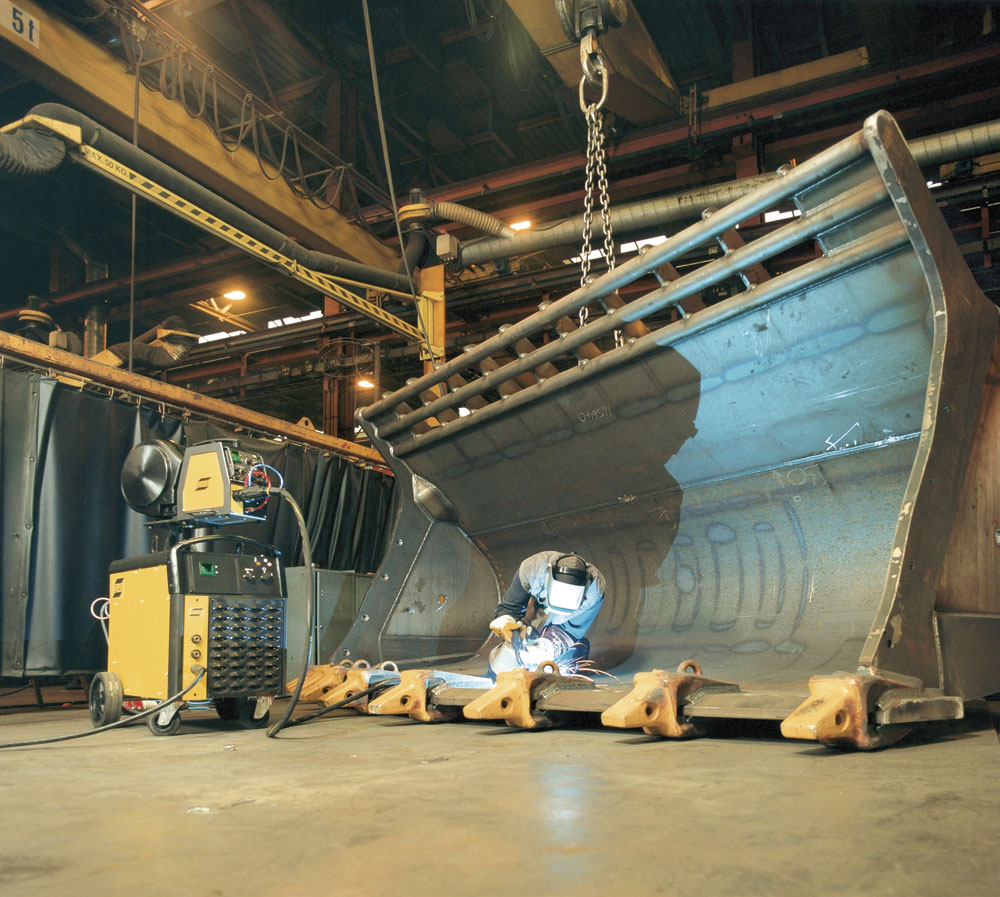Restoring Heavy Machinery By Welding

A look at some of the welding techniques for creating wear-resistant parts
By Peter Wilkins, ESAB
Today, welding and weld overlay techniques are the most frequently used techniques for renovating steel parts in almost every industrial sector.
For example, weld overlay is a highly cost-effective way of parthinery, eg digging tools, shovel teeth, tracks, rails, wheels, rolls etc. In the most extreme environments, digger buckets, crushers and screens may need to be refurbished monthly – so replacement is rarely the sensible option.
As long as there is welding equipment available for someone with welding skills, refurbishment is the answer. In some cases, pre-heating of parts may be necessary and gas will need to be brought to the site.
Larger companies often have their own repair and maintenance teams, while others may need to employ a contractor. The traditional method of welding involves the use of manual metal arc electrodes, which is a relatively slow process, but very convenient in terms of working on site.
Higher-productivity methods known as flux-cored wires do exactly the same process in terms of the composition of the weld but are much faster and, in some cases, require a gas shield.
One good example of the advantage of refurbishment over replacement is twin-wire submerged arc welding, with flux-cored wires, of pistons for large diesel engines. Larger pistons with diameters of 700mm or more can be refurbished with a productivity gain of around 25% without any increase in production costs.
Piston ring grooves wear continuously since they are constantly on the move. The piston head surface also wears, largely due to the extreme thermal conditions in the cylinder.
In a demonstration project carried out by ESAB and their partner, two layers of hard surfacing, with OK Flux 10.80, achieved a surface thickness of 350HB (~37 HRC). Flux-cored wires in the twin-wire mode allowed the replacement of solid wire with basic flux-cored wire (two 2.4mm wires instead of a single 4mm solid).
The wire selected for this demonstration project was OK Tubrod 15.21S (containing 0.5% molybdenum), which offered a high degree of cracking resistance. Thanks to this technique the deposition rate increased by 50% with fewer weld defects and a more consistent bead deposit. Grooves were machined out of the solid material and the resulting pistons were refurbished with fewer layers at a higher welding speed.
Another example is railway wheels. Worn wheels can be given original profiles using a lathe turning process. However, this can result in the loss of a significant amount of useful materials and smaller wheels.
A better way of dealing with wear is to rebuild the worn part by welding the surface using a suitable filler material. Welded material is as good as or, perhaps, even better than the original base material. Fine grinding can also restore the wheel to a profile identical to the original.
In addition, welding can be carried out without removing the wheel or the bearing housing, as both can be welded at the same time using two submerged arc-welding heads. The axle, complete with wheels, is rolled on rails into the bottom of the machine, where build-up welding is performed. Once completed, the axle can be rolled out again.
A manipulator, which is positioned in a ditch, clamps the axle and wheels and rotates them. For welding in the best position, the manipulator and the wheel set can be tilted ±50°.
Two automatic A6 welding heads can be mounted on ESAB MKR columns and booms, allowing the heads to be positioned in the desired location in relation to the wheels. The welding process is either single wire or twin wire (two wires connected to the same power source), while the power sources are two ESAB LAF 1250 for a maximum of 1,250A.The welding process controller is an ESAB computerized PEH process system.
Flux is automatically fed from floor level to the welding heads by means of pressure and hoses with compressed air. ESAB hardfacing solid wires (OK13.90, OK13.89 and OK13.91) can also used for repair and maintenance in a number of industries, including quarrying, mining and railways. These offer highly wear-resistant layers on machinery parts such as digging tools, rails, wheels, shovel teeth and rolls.


